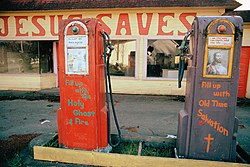1973 oil crisis
The 1973 oil crisis started on October 17, 1973. when the members of Organization of Arab Petroleum Exporting Countries (OAPEC) said, because of the Yom Kippur War, that they would no longer ship petroleum to nations that had supported Israel in its conflict with Syria and Egypt (The United States, Canada, its allies in Western Europe, and Japan). The embargo was lifted in March 1974.
About the same time, OPEC members agreed to raise world oil prices, after attempts at negotiation with the "Seven Sisters" oil company earlier in the month failed. Due to the dependence of the industrialized world on crude oil and the role of OPEC as a major supplier, these price increases hurt the economies of the targeted countries, while at the same time limiting economic activity. The targeted countries responded with new, and mostly permanent, attempts to limit any more dependency.
During this time, many other problems arose. These problems badly affected the economy of the world. The problems continued even after 10 years until the early 1980s. The higher oil prices continued until 1986. Japan did well soon after the 1973 oil crisis. For example, Japanese companies started manufacturing automobiles that used less oil to run. Soon many other automobile companies in different countries also started to manufacture automobiles that used less oil to run. The Japanese also began focusing on producing electronics such as transistor radios and televisions. This production is what helped the Japanese economy to bounce back after the shock of the oil crisis.
1973 Oil Crisis Media
West Texas Intermediate oil price history from 1950 to 2000, adjusted for inflation (1947 prices)
Gasoline ration stamps printed by the Bureau of Engraving and Printing in 1974, but not used
Graph of oil prices from 1861 to 2015, showing a sharp increase in 1973 and again during the 1979 energy crisis. The orange line is adjusted for inflation.








